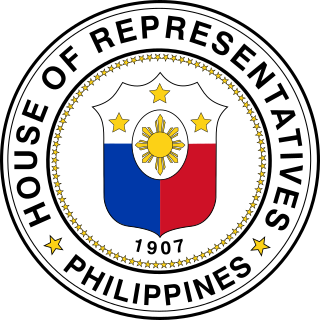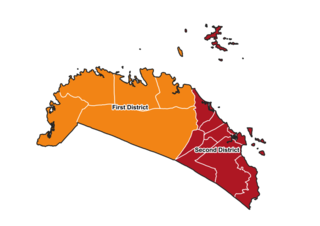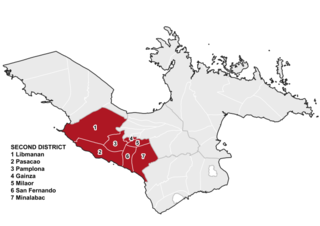
Camarines Norte,officially the Province of Camarines Norte,is a province in the Philippines located in the Bicol Region in Luzon. Its capital is Daet,the most populous town in the province. The province borders Quezon to the west,Camarines Sur to the south,and the Philippine Sea to the north. It has historically been a Bikol-speaking region. However,there has been a language shift in recent years to Tagalog,which is more commonly used nowadays.

The House of Representatives is the lower house of Congress,the bicameral legislature of the Philippines,with the Senate of the Philippines as the upper house. The lower house is commonly referred to as Congress,although the term collectively refers to both houses.
The 1998 election of members to the Senate of the Philippines was the 26th election to the Senate of the Philippines. It was held on Monday,May 11,1998 to elect 12 of the 24 seats in the Senate. The two main competing coalitions in the senatorial election were Lakas—National Union of Christian Democrats—United Muslim Democrats of the Philippines and the Laban ng Makabayang Masang Pilipino umbrella coalition composed of Laban ng Demokratikong Pilipino,Pwersa ng Masang Pilipino,Nationalist People's Coalition,and Partido Demokratiko Pilipino—Lakas ng Bayan. The two coalitions split the 12 contested seats 7–5 in favor of LAMMP.

Vinzons officially the Municipality of Vinzons,is a municipality in the province of Camarines Norte,Philippines. According to the 2020 census,it has a population of 43,485 people.

The legislative districts of Camarines Norte are the representations of the province of Camarines Norte in the various national legislatures of the Philippines. The province is currently represented in the lower house of the Congress of the Philippines through its first and second congressional districts.

The 2007 Philippine House of Representatives elections were held on May 14,2007,to elect members to the House of Representatives of the Philippines to serve in the 14th Congress of the Philippines from June 30,2007,until June 30,2010. The Philippines uses parallel voting for seats in the House of Representatives.

Arnulfo Palma Fuentebella was the Speaker of the Philippine House of Representatives from 2000 to 2001. He was born in Camarines Sur to former governor Felix Fuentebella. He graduated in the University of the Philippines and later became a banker. He later represented of the 3rd district of Camarines Sur,more popularly known as the Partido district. He became the speaker for a year before Fuentebella was de-seated.

Wenceslao "Bintao" Quinito Vinzons Sr. was a Filipino patriot and leader of the Philippine armed resistance against the Japanese invasion in World War II. He was the youngest delegate to the 1935 Philippine Constitutional Convention. For leading demonstrations as a student leader,he was dubbed the "Father of Student Activism in the Philippines" when he,along with Narciso J. Alegre and future Senator and Vice President Arturo Tolentino,founded the Young Philippines Party.

The 2010 Philippine House of Representatives elections were held on May 10,2010,to elect members to the House of Representatives of the Philippines to serve in the 15th Congress of the Philippines from June 30,2010,to June 30,2013. The Philippines uses parallel voting for seats in the House of Representatives;a voter has two votes:one for a representative from one's legislative district,and another for a sectoral representative via closed lists under the party-list system,with a 2% election threshold and 3-seat cap,when the parties with 2% of the national vote or more not meeting the 20% of the total seats,parties with less than 2% of the vote will get one seat each until the 20% requirement is met.

Elections were held in the Bicol Region for seats in the House of Representatives of the Philippines on May 10,2010.

The Camarines Norte Provincial Board is the Sangguniang Panlalawigan of the Philippine province of Camarines Norte.
Elections were held in Bicol Region for seats in the House of Representatives of the Philippines on May 9,2016.

The Marcos family is a political family in the Philippines. They have established themselves in the country's politics,having established a political dynasty that traces its beginnings to the 1925 election of Mariano Marcos to the Philippine House of Representatives as congressman for the second district of Ilocos Norte;reached its peak during the 21-year rule of Ferdinand Marcos as president of the Philippines that included his 14-year dictatorship beginning with the declaration of Martial Law throughout the country;continues today with the political careers of Imelda Marcos,Imee Marcos,and Sandro Marcos;and reached a fresh political apex with the presidency of Bongbong Marcos.

Camarines Sur's 2nd congressional district is one of the five congressional districts of the Philippines in the province of Camarines Sur. It has been represented in the House of Representatives of the Philippines since 1919. The district consists of the west central Camarines Sur municipalities of Gainza,Libmanan,Milaor,Minalabac,Pamplona,Pasacao and San Fernando. It is currently represented in the 18th Congress by Luis Raymund Villafuerte of the National Unity Party (NUP).

Camarines Norte's 1st congressional district is one of the two congressional districts of the Philippines in Camarines Norte. It has been represented in the House of Representatives of the Philippines since 2010. Previously included in Camarines Norte's at-large congressional district,it includes the western half of the province,bordering Quezon. It is currently represented in the 19th Congress by Josefina Tallado of the Lakas–CMD.

Camarines Norte's 2nd congressional district is one of the two congressional districts of the Philippines in Camarines Norte. It has been represented in the House of Representatives of the Philippines since 2010. Previously included in Camarines Norte's at-large congressional district,it includes the eastern half of the province,bordering Camarines Sur. It is currently represented in the 19th Congress by Rosemarie C. Panotes of the Lakas–CMD.
Camarines Norte's at-large congressional district refers to the lone congressional district of the Philippines in the province of Camarines Norte for various national legislatures before 2010. The province first elected its representatives provincewide at-large in 1919 following the dissolution of Ambos Camarines into the present provinces of Camarines Norte and Camarines Sur. It was a single-member district for the final six legislatures of the Insular Government of the Philippine Islands from 1919 to 1935,the three legislatures of the Commonwealth of the Philippines from 1935 to 1946,the seven congresses of the Third Philippine Republic from 1946 to 1972,the national parliament of the Fourth Philippine Republic from 1984 to 1986,and the 8th to 14th congresses of the Fifth Philippine Republic from 1987 to 2010.














